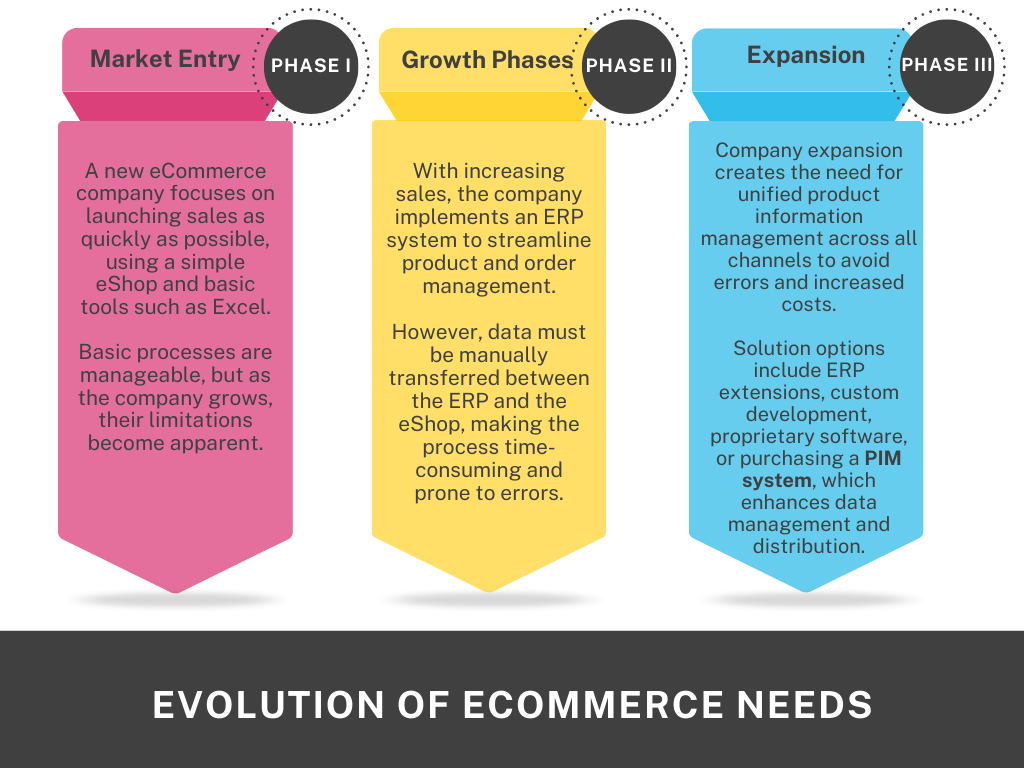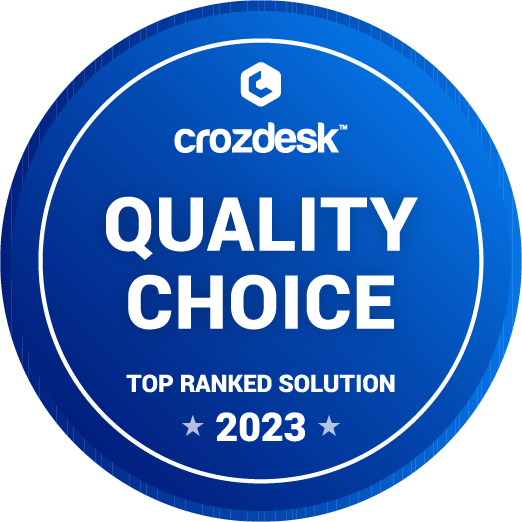The Growth Stages of eCommerce Companies: From Spreadsheets to PIM Systems
Introduction
As an eCommerce company grows, its needs change. What works in the beginning may not be enough later. A new company might start with simple tools, like a spreadsheet for managing products or basic accounting software. However as the number of orders increases and the product range expands, more reliable and efficient tools are needed to handle larger data volumes and complex processes.
Understanding this step-by-step growth—from a basic online shop to centralized product management—is crucial for choosing the right time to invest in systems like PIM (Product Information Management). Let’s look at the typical path eCommerce businesses take as they develop.
Stage I: “Quick to Market”
A newly established eCommerce company needs to start selling as quickly as possible. In this initial phase, the company usually uses a simple eShop, often using a pre-made template. It has only a few employees and simple processes. Most of the spare cash is invested in merchandise, with minimal funds for further investment.
At this stage, an Excel spreadsheet is normally enough to manage the products. Accounting and orders are also often managed using simple tools. This solution is sufficient for a small volume of products and orders, but as the business grows it starts to hit its limits.
Stage II: “We’re Growing, We Need a System”
When sales increase and revenue rises, more structure is needed for managing data and processes. Many companies at this stage start using an ERP (Enterprise Resource Planning) system, often a smaller and budget-friendly version. Product information is managed in two places: the ERP and the website. We have already explained the functions and advantages of the ERP system in detail in the previous article.
Initially, this system works well, handling basic data like product names, codes, prices, and stock levels, which are manually entered into the eShop. However, as the number of products and orders grows, this process becomes more time-consuming and prone to errors. At this point, companies start thinking about integrating ERP with the website for automatic product updates. This integration allows basic data to be transferred from the ERP to the site, while employees can add details like descriptions and images.
Despite the potential for automation, companies in this phase often prioritize quicker returns on investment, such as listing products on new marketplaces, improving SEO, or expanding to foreign markets. These strategies help attract new customers and boost revenue.
If the company has few products or sells only on one platform, these processes can work for a long time without major issues. The company hires more staff to manage catalogs and orders, but over time, mistakes happen due to outdated or incorrect data. These errors are usually not severe enough to require immediate action.
Stage III: “We Need Centralized Product Management”
When the company expands its product range, enters international markets, or starts B2B sales, managing product information becomes more complex. This leads to higher costs and more frequent errors, which can result in more returns and canceled orders. At this stage, the need for central product management across all channels becomes critical.
How to Address This Need? There are several options, each with its pros and cons:
1. ERP System Solution
Ideally, the ERP could handle all product information. However, most ERPs lack the features needed for managing products across various sales channels. This is why some ERP providers partner with PIM systems that can transfer data between ERP and PIM. Some large ERPs offer special eCommerce modules, but these can be expensive.
2. The Development of Custom ERP System
Companies can hire system integrators to add product management functions to their ERP. This approach can be expensive and requires experienced partners to ensure new features stay compatible with future ERP updates. When done well, this can be a good solution, but it often involves significant investment.
3. Custom Software Outside ERP
A company can create its own software outside the ERP to handle product information and connect with the ERP. This can be more affordable and makes ERP updates easier but demands IT resources and time. Small and medium-sized companies usually lack the capacity for such projects, making them time consuming and expensive.
4. Purchasing a PIM System
Another option is buying a PIM system designed specifically for product information management. PIM pulls data from the ERP and allows additional product information (like descriptions, marketing texts, photos, and data for different markets) to be added. It then distributes this data across all sales channels, keeping it updated. All users work in one system, reducing errors and saving time.

Why Choose a PIM System?
PIM systems are attractive because they are specialized for managing product information, filling the gaps left by ERPs. They import data from the ERP and make it easy to add extra information. PIM also offers smart tools and automation for efficient data management.
A major advantage of PIM is the central distribution of data to multiple sales channels, reducing inconsistencies and increasing efficiency. For companies with a wide product range and multi-channel strategy, PIM becomes an invaluable tool.
Things to Consider Before Implementing a PIM System
Before choosing a PIM system, consider key factors. Integrating PIM with the existing ERP system and sales channels often requires a software project that needs careful planning and time. While this project is simpler than some other options, it still takes time and investment. Quality PIM providers, such as WisePorter, make the process easier with ready-made connectors that lower costs and risks.
Conclusion
The journey of an eCommerce company from simple tools to advanced systems like PIM shows the importance of timing and investment in technology. Initially, basic solutions work for handling processes, but as product and order volumes grow, the need for reliable tools also increases.
Implementing an ERP system or moving to centralized product management with a PIM system helps companies handle complex operations better and reduce errors. Choosing and adopting these systems can make the difference between successful expansion and stagnation. It’s crucial for companies to evaluate their current needs and growth plans to choose the right solution for long-term efficiency and competitiveness.
Want to reduce data entry errors and simplify the process of distributing product information across all channels? WisePorter will offer you a flexible and simple solution to your woes, ensuring your customers’ satisfaction. Move your business from operations to strategy and try the DEMO version for free!




